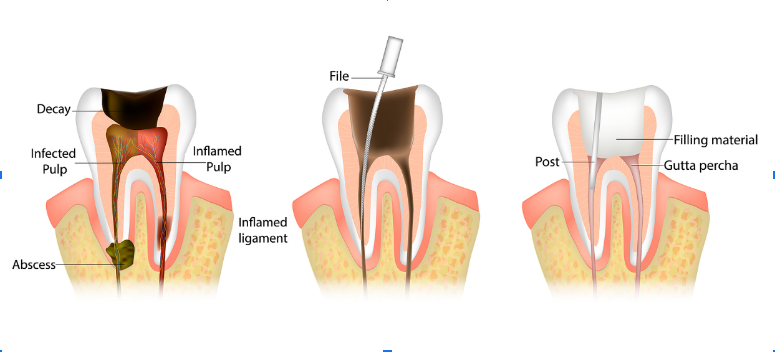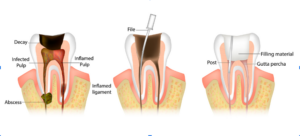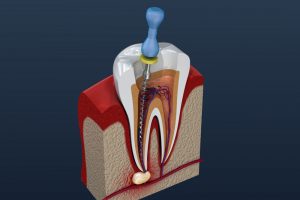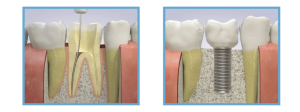
If you’re in need of a root canal, you might be seeking clarity and reassurance. Direct and to the point: a root canal is a standard treatment used to repair and save a tooth that is infected or badly decayed. While it might sound daunting, this article demystifies the procedure, from why it’s necessary to how it’s performed and what you can expect for recovery. With current dental technologies, comfort is a priority. Let’s explore root canal treatment without the fluff, addressing your concerns at every step.
Key Takeaways
- Root canal treatment is a dental procedure designed to remove infected dental pulp, clean the root canal, and save a natural tooth from extraction while maintaining its functionality and appearance.
- The root canal procedure is typically a multi-step process that includes diagnosis through symptoms and X-rays, local anesthesia, tooth preparation with a dental dam, cleaning and shaping the root canals, removing infected pulp, and filling the canals with gutta-percha followed by a temporary filling and future crown placement.
- Post-root canal care involves managing pain and sensitivity with medication, avoiding certain activities to aid healing, and attending follow-up appointments; alternatives to root canal treatments do exist but can present complexities and costs, while prevention through good oral hygiene and lifestyle choices is key to reducing the likelihood of requiring the procedure.
Understanding Root Canal Treatment
 Think of your tooth as a mini castle. Within this castle lies a soft core, the dental pulp, which though necessary for tooth growth, isn’t needed for a fully grown tooth’s functionality. Sadly, this fortress can come under attack from bacteria, leading to an infected root canal. This is where the hero of our story steps in – the root canal treatment. Its mission? To eliminate bacteria from the infected root canal, save the natural tooth, and prevent future reinfection.
Think of your tooth as a mini castle. Within this castle lies a soft core, the dental pulp, which though necessary for tooth growth, isn’t needed for a fully grown tooth’s functionality. Sadly, this fortress can come under attack from bacteria, leading to an infected root canal. This is where the hero of our story steps in – the root canal treatment. Its mission? To eliminate bacteria from the infected root canal, save the natural tooth, and prevent future reinfection.
The advantages of a root canal procedure include:
- Infection removal
- Maintenance of efficient chewing and normal biting force
- Preservation of sensation
- Natural appearance, preventing excessive wear or strain on other teeth
It’s like giving your tooth a second chance at life!
What is a Root Canal?
The term ‘root canal’ isn’t as intimidating as it seems. In fact, it’s just a name for a dental procedure that involves:
- the removal of the soft center of the tooth, known as the pulp
- a deep clean
- a removal of all things harmful
- keeping your tooth healthy and functioning
Think of it as a deep clean, a removal of all things harmful, to keep your natural teeth healthy and functioning.
While the term ‘root canal’ may induce some anxiety, the procedure is a common one, performed by skilled professionals known as endodontists. With modern technology and anesthetics, a root canal is as comfortable as getting a filling. But how long does a root canal take?
Why You Might Need a Root Canal
Having understood what a root canal treatment involves, it’s time to explore the reasons why one might require it. Damage to the pulp can be caused by various factors such as:
- deep decay
- repeated dental procedures
- a crack or chip in the tooth
- injuries, genetics, or trauma
These factors can damage the pulp, leading to the necessity of a root canal.
However, it’s not all doom and gloom. Promptly addressing dental pain and issues can rectify problems before they escalate to the severity of requiring a root canal. Remember, prevention is always better than cure!
The Root Canal Procedure: Step-by-Step

After grasping why one might require a root canal, let’s unravel the actual procedure. Typically performed by a dentist or endodontist, a root canal treatment usually spans across 1 or 2 or more appointments. Much like going on an adventure, this journey is taken step by step, ensuring every aspect of the process is as comfortable and pain-free as possible.
The root canal procedure typically involves the following steps:
- Administering local anesthesia to prevent pain during the procedure.
- Using specialized files to remove the infected or damaged pulp from the tooth.
- In complex cases, an endodontist, a specialist in root canal treatment, might be called upon to perform the procedure.
Diagnosis and X-rays

The path to a root canal treatment starts with identifying the symptoms. These can include:
- Severe pain during chewing or biting
- Sensitivity to hot and cold temperatures
- Persistent toothache
- Pimples on the gums
- Swollen or tender gums
- Deep decay
After recognizing these symptoms, a dental check-up takes place to assess the painful tooth for signs of damage that may require a root canal. X-rays play a critical role in this process, providing a detailed view of the tooth’s condition and verifying the need for a root canal treatment.
Preparing the Tooth
Upon diagnosis confirmation and determination of the need for a root canal, tooth preparation commences. It starts with the administration of local anesthesia to numb the affected tooth, ensuring the patient does not feel pain during the procedure.
A dental dam is positioned around the tooth to:
- Keep it separate from the rest of the mouth throughout the procedure
- Maintain a dry field and minimize the risk of contamination
- Put up a protective shield around the tooth, keeping it safe and dry while the procedure takes place
This step is crucial to ensure the success of the procedure, as it directly affects the blood vessels involved.
Cleaning and Filling the Root Canal

Once the infected tooth is ready, the main procedure kicks off. The infected pulp or inflamed tooth pulp is removed from within the tooth. This step is vital to prevent further infection and alleviate pain. Think of it as a knight in shining armor, rescuing the fortress (your tooth) from invaders (bacteria).
Once the pulp is removed, dental files are used to meticulously clean and shape the root canals. This ensures an optimal fit for the filling material. In some cases, medication may be placed within the root canal between treatment sessions to ensure the elimination of residual bacteria.
Finally, a material called gutta-percha is used to fill the cleaned and disinfected root canal space, providing a stable and inert material to seal the canal and preclude reinfection.
Post-Treatment Care and Recovery

The conclusion of the root canal procedure doesn’t mark the end of the journey. It’s now time for the recovery phase. Patients are usually advised to avoid chewing with the treated tooth until it has been permanently filled or crowned, and to avoid eating, drinking hot or cold liquids, or smoking for at least the first hour post-treatment.
Post-root canal pain management is also crucial. Over-the-counter medication can be used, or stronger prescription narcotics if necessary, while tenderness in the area and jaw soreness are common sensations to experience.
Regular oral hygiene practices can be resumed post-treatment, with special gentleness around the treated tooth and surrounding soft tissue during brushing and flossing.
Temporary Filling and Crown Placement
A temporary filling is applied to seal the tooth until a permanent restoration is installed and prevent bacteria from entering. It’s like placing a bandage over a wound, protecting it from external harm while it heals.
Once the temporary filling has done its job, a permanent crown is placed as the final step in protecting and restoring the structure after root canal treatment. It’s like placing a sturdy, impenetrable roof over the fortress, ensuring it’s well-protected from future attacks.
Managing Pain and Sensitivity
After the procedure, it’s normal to experience increased sensitivity or discomfort in the tooth area for a few days. But don’t worry, most people find that the pain they experience after a root canal is mild and temporary, lasting only a few days.
To manage this, over-the-counter medications like acetaminophen and NSAIDs such as Motrin, Aleve, and Advil are generally effective in alleviating post-root canal pain. And remember, if severe or worsening pain occurs after two or three days following a root canal, or if there is visible swelling or a temporary filling comes out, it is advised to seek immediate dental attention.
Follow-Up Appointments
Scheduling regular dental checkups after the procedure is critical to ensure the success of the root canal treatment and to monitor for any future pain or swelling that might indicate issues. During these follow-up appointments, X-rays are taken to confirm that the infection has been fully eradicated, and the dentist replaces the temporary filling with a permanent one or a crown as needed.
While it may seem like a lot of effort, remember that these measures are taken to ensure the health and longevity of your tooth. In some cases, a tooth that has undergone root canal treatment may require re-treatment years later, yet often the tooth can still be saved.
Root Canal Alternatives and Cost Considerations
Even though a root canal treatment is a proven method, alternative treatments do exist. These include tooth extraction, endodontic surgery, dental implants or the placement of removable partial dentures. It’s always good to know your options and discuss them with your dentist.
However, akin to all valuable things in life, root canal treatments carry a price tag. It’s important to consider these factors, as root canal costs can greatly vary depending on factors such as location, provider, and dental insurance coverage.
Alternative Treatments
Tooth extraction is often considered an alternative to root canal treatment. However, it’s not the only option. Following a tooth extracted, replacement options such as bridges or implants are typically considered.
These alternatives, while valid, often come with their own set of complications and costs. Therefore, it’s important to carefully consider all options and consult with your dentist before making a decision.
Factors Affecting Root Canal Cost
Comprehending the elements influencing the cost of a root canal can aid in planning and budgeting for the procedure. Generally, root canal procedures cost between $800 to $2,500 per tooth. Interestingly, prices for root canal treatments are often higher in urban areas compared to rural or suburban locations.
Also, specialized practitioners like endodontists typically charge more for root canal treatments due to their specialization compared to general dentists. Lastly, dental insurance can substantially decrease the out-of-pocket costs for a root canal procedure.
Tips for Preventing the Need for Root Canal Treatment

Although we’ve delved into the process, alternatives, and costs of a root canal treatment, it’s vital to bear in mind that prevention always trumps curing. Practicing good oral hygiene and avoiding tooth decay and damage can help prevent the need for a root canal treatment.
Limiting the intake of acidic foods and beverages can help protect enamel from damage, thereby lowering the risk of requiring root canal treatment. These preventive measures can go a long way in maintaining the health of your teeth and avoiding costly dental procedures.
Proper Oral Hygiene
Upholding good oral hygiene serves as the primary defense against dental infections. This includes brushing teeth at least twice daily for a minimum of two minutes, including all surfaces such as the tongue, gums, and inner cheeks.
Flossing once daily helps eliminate food particles and bacteria from hard-to-reach places between teeth, reducing the risk of cavities and subsequent root canal treatments. Using fluoride toothpaste and mouth rinses reinforces tooth enamel and fights against plaque, which is integral in preventing tooth decay and root canals.
Lastly, limiting consumption of acidic and sugary foods and beverages is vital to protect tooth enamel from erosion and decay, preventing the potential need for root canal treatments.
Avoiding Tooth Decay and Damage
In addition to good oral hygiene, it’s imperative to adopt measures to avert tooth decay and damage. This can be achieved by wearing a mouth guard during sports and for those who grind their teeth at night.
Avoiding hard foods like candies and crunchy vegetables can help prevent chips or cracks in teeth, which can expose the tooth’s root and lead to root canals. Also, not using teeth as tools to open bottles or tear plastic can prevent fractures where bacteria can travel to the nerves or root.
These measures, coupled with good oral hygiene, can significantly reduce the risk of needing a root canal.
Summary
In summary, root canal treatment is a common dental procedure aimed at saving an infected tooth. While the process might seem intimidating, understanding each step can alleviate fears and misconceptions. Post-procedure care is crucial for successful recovery and long-term preservation of the treated tooth.
In conclusion, while root canal treatments are effective, preventive measures such as maintaining good oral hygiene and taking care of teeth can help avoid the need for such procedures. Remember, your teeth are a vital part of your overall health, and taking care of them should be a priority.
Frequently Asked Questions
What is a root canal treatment?
A root canal treatment is a dental procedure that removes bacteria from an infected root canal, prevents future reinfection, and preserves the natural tooth.
Why might I need a root canal?
You might need a root canal if the pulp of your tooth is damaged due to deep decay, repeated dental procedures, or a crack or chip in the tooth. It is essential to consult a dentist for proper evaluation and treatment.
What does the root canal procedure involve?
The root canal procedure involves diagnosing the need for a root canal, preparing the tooth for treatment, and cleaning and filling the root canal. It is a necessary treatment for addressing infected or damaged tooth pulp.
What care is needed after a root canal treatment?
After a root canal treatment, it’s important to avoid chewing with the treated tooth until it’s permanently filled or crowned, manage pain with medication, and attend follow-up appointments for checkups and permanent filling. This will help ensure proper healing and long-term success of the treatment.
How can I prevent the need for a root canal treatment?
To prevent the need for a root canal treatment, it’s important to practice good oral hygiene, avoid tooth decay and damage, and visit your dentist regularly for checkups.


